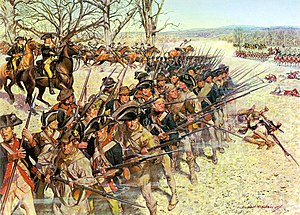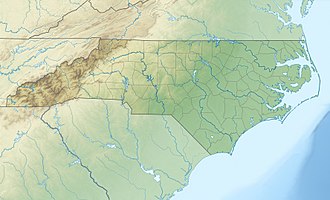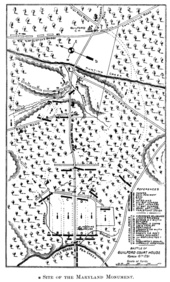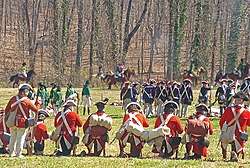Battle of Guilford Court House
The Battle of Guilford Court House was fought on March 15, 1781, during the American Revolutionary War, at a site which is now in Greensboro, the seat of Guilford County, North Carolina. A 2,100-man British force under the command of Lieutenant General Charles Cornwallis defeated Major General Nathanael Greene's 4,500 Americans. The British Army, however, suffered a considerable number of casualties during the battle (with estimates as high as 27% of their total force).[9]
| Battle of Guilford Court House | |||||||
|---|---|---|---|---|---|---|---|
| Part of the American Revolutionary War | |||||||
 Battle of Guilford Court House, H. Charles McBarron Jr. | |||||||
| |||||||
| Belligerents | |||||||
|
|
| ||||||
| Commanders and leaders | |||||||
|
|
| ||||||
| Strength | |||||||
| 2,100[1] | 4,500[1] | ||||||
| Casualties and losses | |||||||
|
93 killed 408 wounded 25 missing or captured[2][3] |
79-94 killed[4][5] 184-211 wounded[6] 75 wounded prisoners[4][7] 929-971 missing[4][7][8] | ||||||
 Location within North Carolina | |||||||
The battle was "the largest and most hotly contested action"[10] in the American Revolution's southern theater. Before the battle, the British had great success in conquering much of Georgia and South Carolina with the aid of strong Loyalist factions, and thought that North Carolina might be within their grasp. In fact, the British were in the process of heavy recruitment in North Carolina when this battle put an end to their recruiting drive. In the wake of the battle, Greene moved into South Carolina, while Cornwallis chose to march into Virginia and attempt to link up with roughly 3,500 men under British Major General Phillips and American turncoat Benedict Arnold. These decisions allowed Greene to unravel British control of the South, while leading Cornwallis to Yorktown where he was eventually forced to surrender to General George Washington and French Lieutenant General Comte de Rochambeau.
The battle is commemorated at Guilford Courthouse National Military Park and associated Hoskins House Historic District.
Prelude
Following the Battle of Cowpens in South Carolina, Lt. General Charles Cornwallis was determined to destroy Greene's army. But the loss of his light infantry at Cowpens led him to burn his supplies so that his army would be nimble enough for pursuit. He chased Greene in the "Race to the Dan", but Greene escaped across the flooded Dan River to safety in Virginia. Cornwallis established camp at Hillsborough, foraged for supplies and recruited North Carolina Tories. Both the bedraggled state of his army and Pyle's massacre, however, deterred Loyalists from turning out. Due to the fighting, thousands of slaves had escaped from plantations in South Carolina and other southern states, many joining the British to fight for their personal freedom. In the waning months of the war, the British evacuated more than 3,000 freedmen to Nova Scotia, with others going to London and Jamaica. Northern slaves escaped to the British lines in occupied cities such as New York.
On March 14, 1781, while encamped in the forks of the Deep River, Cornwallis was informed that Greene was encamped at the Guilford Court House. With him was a body of North Carolina militia, plus reinforcements from Virginia, consisting of 3,000 Virginia militia, a Virginia State regiment, a corps of Virginian eighteen-month men, and recruits for the Maryland Line, totaling between 4,000 and 5,000 men. Cornwallis decided to give battle, though he had only 1,900 men at his disposal. He detached his baggage train, 100 infantry, and 20 cavalry under the command of Lieutenant Colonel Hamilton, to Bell's Mills further down the Deep River. Before breakfast could be eaten, Cornwallis set off with his main force, arriving at Guilford at midday.
Order of Battle
Battle
.jpg)
The advance guard met near the Quaker New Garden Meeting House. Dragoons from Banastre Tarleton's British Legion were briefly engaged by Light Horse Harry Lee's Dragoons about 4 miles (6.4 km) from the Guilford Court House. The British 23rd Regiment of Foot sent reinforcements forward and Lee withdrew, ordering a retreat to Greene's main body.
Cornwallis found the Americans in position on rising ground about one and a half miles (2.4 km) from the court house. He was unable to gain much information from his prisoners or the local residents as to the American disposition. To his front he saw a plantation with a large field straddling both sides of the road, with two more further over on the left separated by 200 yards or so of woodland. To his right beyond the fields the woodland extended for several miles. On the far side of the first field was a fenced wood, 1-mile (1.6 km) in depth, through which the road passed into an extensive cleared area around the court house. Along the edge of this woodland was a fence forming the American first line of defense and a six-pound cannon on each side of the road.
Greene had prepared his defense in three lines. North Carolina militia formed the first line, with backwoods riflemen on the left and right flanks to harass the advancing British. In the second line, he placed the Virginia militia. Two more six-pound cannons were sited on the center of the line. His third and strongest line consisting of his regulars, included the Virginian regiment, Delaware infantry, and the 1st and 2nd Maryland regiments were 400 yards further on, though placed at an angle to the west of the road. While superficially resembling the deployment successfully used by Daniel Morgan at Cowpens, the lines were hundreds of yards apart and could not support one another.

Since the east side of the road was mostly open, Cornwallis opted to attack up the west side and, following a short barrage of cannon shot on the cannon positions of the first line, at 1:30 p.m., Cornwallis moved his men forward. When they were about 150 yards short of the fence, a volley was fired from the Americans, but the British continued until they were within musket shot then fired their own volley in return. On a command from Webster, they charged forward, coming to a halt 50 paces from the American lines because the North Carolina militia, as noted by Sergeant Lamb of the 23rd Regiment "had their arms presented and resting on the picket fence...they were taking aim with nice precision". Urged onward by Lieutenant Colonel James Webster of the 33rd Regiment of Foot, the British continued to advance. Though the North Carolina militia, to the west of the road, had been instructed to fire two to three volleys, they fired their muskets, then turned and fled back through the woods, some reported to have discarded their personal equipment as they ran. Before they retreated, the militia inflicted heavy casualties on the British. One officer of the 71st Regiment claimed that "one half of the Highlanders dropped on that spot."[11] The British advanced on the second line. Heavy resistance was shown, but Webster pushed around the flank and on to the American 3rd line. The British army forced its way through the first two lines with significant losses, but the woodland was too dense to allow practical use of the bayonets.
The 71st Regiment, grenadiers and 2nd Guards moved up the center, following the musket shots from the 33rd and 23rd regiments to their left. To the right, the 1st Guards and Hessians were being harried by Lee's Legion. The British guns and Tarleton's light dragoons moved forward along the road, keeping pace. The 2nd Guards in the center found themselves coming out into open ground around the court house to the left of the Salisbury road. They spotted a large force of Continental infantry, and immediately attacked them and captured two six-pounders. They then pursued the Continentals into the woods, but were repulsed by Lt. Col. William Washington's light dragoons and the 1st Maryland Regiment, abandoning the two guns they had just captured. Lieutenant John Macleod, in command of two British three-pounders, had just arrived and was directed by Cornwallis to fire on the Dragoons and the British alike.

While many British soldiers were killed by friendly fire, the Americans broke off and retreated from the field. Cornwallis ordered the 23rd and 71st regiments, with part of the cavalry, to pursue the Americans, though not for any great distance. Tarleton and the remainder of the dragoons were sent off to the right flank to join Bose and put an end to the action from Washington.
During the battle, Cornwallis had a horse shot from under him. American colonel Benjamin Williams was later decorated for his personal bravery at Guilford Courthouse.
After
The battle lasted only ninety minutes. The British were outnumbered more than two to one, yet defeated the American force. In doing so, however, almost a quarter of their force became casualties. The Americans withdrew intact, which accomplished Greene's primary objective.

The British, by taking ground with their accustomed tenacity when engaged with superior numbers, were victorious. However, Cornwallis had suffered unsustainable casualties and subsequently withdrew to the coast to re-group, leaving the Americans with the strategic advantage.[12] Seeing this as a classic Pyrrhic victory, British Whig Party leader and war critic Charles James Fox echoed Plutarch's famous words by saying, "Another such victory would ruin the British Army!"[13]
In a letter to Lord George Germain delivered by his aide-de-camp Captain Broderick, Cornwallis commented: "From our observation, and the best accounts we could procure, we did not doubt but the strength of the enemy exceeded 7,000 men...I cannot ascertain the loss of the enemy, but it must have been considerable; between 200 and 300 dead were left on the field of battle...many of their wounded escaped...Our forage parties have reported to me that houses in a circle six to eight miles around us are full of others...We took few prisoners".
He went on to comment further on the British force: "The conduct and actions of the officers and soldiers that composed this little army will do more justice to their merit than I can by words. Their persevering intrepidity in action, their invincible patience in the hardships and fatigues of a march of above 600 miles, in which they have forded several large rivers and numberless creeks, many of which would be reckoned large rivers in any other country in the world, without tents or covering against the climate, and often without provisions, will sufficiently manifest their ardent zeal for the honour and interests of their Sovereign and their country."
After the battle, the British were spread across a large expanse of woodland without food and shelter, and during the night torrential rains started. Fifty of the wounded died before sunrise. Had the British followed the retreating Americans, they might have come across their baggage and supply wagons which had been left where the Americans had camped on the west of the Salisbury road prior to the battle.
On March 17, two days after the battle, Cornwallis reported his casualties as 3 officers and 88 men of other ranks killed, and 24 officers and 384 men of other ranks wounded, with a further 25 men missing in action.[14] Webster was wounded during the battle and died two weeks later. Lieutenant-Colonel Tarleton, commander of the loyalist provincial British Legion, was another notable officer who was wounded, having lost two fingers after taking a bullet in his right hand.[15]
Greene reported his casualties as 57 killed, 111 wounded and 161 missing for the Continental troops and 22 killed, 74 wounded and 885 missing for the militia, a total of 79 killed, 185 wounded and 1,046 missing.[4] Of those reported missing, 75 were wounded men who were captured by the British.[16] When Cornwallis resumed his march, these 75 wounded prisoners were left behind at Cross Creek,[7] Cornwallis having earlier left 70 of his own most severely wounded men at the Quaker settlement of New Garden[17] near Snow Camp. An analysis of Revolutionary pension records by Lawrence E. Babits and Joshua B. Howard led the authors to conclude that Greene's killed and wounded at the Battle were "probably 15-20 percent higher than shown by official returns", with a likely "90-94 killed and 211-220 wounded."[18] Apart from the wounded prisoners, most of the other men who were returned as 'missing' were North Carolina militiamen who went straight back to their homes after the battle.[19]
To avoid another Camden, Greene retreated with his forces intact. With his small army, less than 2,000 strong, Cornwallis declined to follow Greene into the back country. Retiring to Hillsborough, he raised the royal standard, offered protection to the inhabitants, and for the moment appeared to be master of Georgia and the two Carolinas. In a few weeks, however, he abandoned the heart of the state and marched to the coast at Wilmington, North Carolina, to recruit and refit his command.
At Wilmington, the British general faced a serious problem. Instead of remaining in North Carolina, he was determined to march into Virginia, justifying the move on the ground that until Virginia was reduced, he could not firmly hold the more southerly states he had just overrun. General Clinton sharply criticized the decision as unmilitary, and as having been made contrary to his instructions. To Cornwallis he wrote in May: "Had you intimated the probability of your intention, I should certainly have endeavoured to stop you, as I did then as well as now consider such a move likely to be dangerous to our interests in the Southern Colonies." For three months, Cornwallis raided every farm or plantation he came across, from which he took hundreds of horses for his Dragoons. He converted another 700 infantry to mounted duties. During these raids, he freed thousands of slaves, of whom 12,000 joined his own force.
General Greene boldly pushed down towards Camden and Charleston, South Carolina, with a view to drawing his antagonist after him to the points where he was the year before, as well as to driving back Lord Rawdon, whom Cornwallis had left in that field. In his main object—the recovery of the southern states—Greene succeeded by the close of the year, but not without hard fighting and repeated reverses. "We fight, get beat, rise, and fight again," were his words.
Legacy


Every year, on or about March 15, re-enactors in period uniforms present a tactical demonstration of Revolutionary War fighting techniques on or near the battle site, major portions of which are preserved in the Guilford Courthouse National Military Park, established in 1917. Recent research has shown that the battlefield extended into the area now within the boundaries of the adjacent Greensboro Country Park to the east.
Three current Army National Guard units (116th IN,[20] 175th IN[21] and 198th SIG[22]) are derived from American units that participated in the Battle of Guilford Courthouse. There are only thirty Army National Guard and active Regular Army units with lineages that go back to the colonial era.
On Sunday, March 13, 2016, a Crown Forces Monument was opened at the Guilford Courthouse National Military Park in honor of the officers and men of Cornwallis's army.[23][24]
The town of Gilford, New Hampshire, despite a clerical error in the spelling, is named after the battle.[25] A New Hampshire historical marker there, number 118,[26] commemorates the naming.
See also
- Snow Camp Outdoor Theater which tells some of the story of the aftermath of the battle through the play. The Sword of Peace, by William Hardy.
References
- Savas, Theodore P. and J. David Dameron. A Guide to the Battles of the American Revolution. New York: Savas, Beattie LLC, 2010. ISBN 978-1-932714-94-4. p. 286.
- Babits and Howard (2009) page 173
- Rodgers, 1977. p. 224.
- Guilford Courthouse: A Pivotal Battle in the War for Independence, a National Park Service Teaching with Historic Places (TwHP) lesson plan gives 79 killed, 185 wounded. The difference between Savas with 70 and NPS with 79 could be a typo in one of the sources.
- Babits and Howard (2009), page 175
- Babits and Howard (2009), page 175
- Showman, Conrad and Parks (editors), 'The Papers of General Nathanael Greene', Volume 7, University of North Carolina Press, 1994, ISBN 978-0807820940), page 441, gives 75 wounded prisoners and 971 missing, totaling the same 1,046 missing shown by Savas
- The maximum figures for killed and wounded (94 killed and 211 wounded) leave 42 fewer men unaccounted for than the minimum numbers (79 killed and 184 wounded).
- Babits, Lawrence E.; Howard, Joshua B. (2009). Long, Obstinate, and Bloody: The Battle of Guilford Courthouse. The University of North Carolina Press. p. 122.
- "Guilford Courthouse National Military Park". Museum Management Program. National Park Service, U.S. Department of the Interior. Retrieved January 26, 2017.
- "The American Revolution - (The Battle of Guilford Courthouse)". www.theamericanrevolution.org. Archived from the original on 2015-11-15. Retrieved 2015-11-02.
- McGrath, Nick. "Battle of Guilford Courthouse". George Washington’s Mount Vernon: Digital Encyclopedia. Mount Vernon Ladies’ Association. Retrieved January 26, 2017.
In three hours, Cornwallis’s army took possession of the field, but it was a Pyrrhic victory.... Cornwallis could not afford the casualties his army sustained, and withdrew to Wilmington. By doing so, Cornwallis ceded control of the countryside to the Continentals.
- Baker, Thomas E. Another Such Victory, Eastern Acorn Press, 1981, ISBN 0-915992-06-X
- The British Army of the 18th Century, pg.224
- Tarleton Archived 2017-04-27 at the Wayback Machine; essay by Janie B. Cheaney; retrieved;[ISBN unspecified]
- Showman, The Papers of General Nathanael Greene, Volume 7, page 441, referring to a letter sent by Major Charles Magill to Governor Thomas Jefferson of Virginia on March 19, 1781.
- Buchanan, John. The Road to Guilford Courthouse: The American Revolution in the Carolinas Wiley, 1999, pp. 382, ISBN 0-471-32716-6
- Babits and Howard (2009), p. 175
- Savas and Dameron (2010), p. 291.
- Department of the Army, Lineage and Honors, 116th Infantry. Reproduced in Sawicki 1981, pp. 227–229.
- Department of the Army, Lineage and Honors, 175th Infantry. Reproduced in Sawicki 1982, pp. 343–345.
- Department of the Army, Lineage and Honors, 198th Signal Battalion.
- Crown Forces Monument, guilfordbattlegroundcompany, retrieved 2015-11-02
- Crown Forces Monument, wfmynews2, retrieved 2015-11-02
- Coolidge, Austin J.; John B. Mansfield (1859). A History and Description of New England. Boston, Massachusetts: A.J. Coolidge. p. 500.
coolidge mansfield history description new england 1859.
- "New Hampshire Historical Highway Markers" (PDF). NH.gov. New Hampshire Division of Historical Resources. November 2, 2018. Retrieved July 4, 2019.
Further reading
- Agniel, Lucien. The late affair has almost broke my heart;: The American Revolution in the South, 1780-1781 Chatham Press, 1972, ISBN 0-85699-036-1.
- Babits, Lawrence E. and Howard, Joshua B. Long, Obstinate, and Bloody: The Battle of Guilford Courthouse University of North Carolina Press, 2009, ISBN 978-0-8078-3266-0
- Baker, Thomas E. Another Such Victory: The Story of the American Defeat at Guilford Courthouse that Helped Win the War for Independence Eastern National, 1999, ISBN 0-915992-06-X.
- Chidsey, Donald Barr. The war in the South: The Carolinas and Georgia in the American Revolution Crown Publishers, 1971.
Carolina Press, Chapel Hill and London, ISBN 978-0-8078-2094-0.
- Davis, Burke. The Cowpens-Guilford Courthouse Campaign University of Pennsylvania Press, 2002, ISBN 0-8122-1832-9.
- Hairr, John. Guilford Courthouse Da Capo Press, 2002, ISBN 0-306-81171-5.
- Konstam, Angus. Guilford Courthouse 1781: Lord Cornwallis's Ruinous Victory Osprey Publishing, 2002, ISBN 1-84176-411-6.
- Lumpkin, Henry. From Savannah to Yorktown: The American Revolution in the South Paragon House, 1987, ISBN 0-595-00097-5.
- Rodgers, H.C.B. "the British Army in the 18th Century" George Allen & Unwin Ltd., 1977
- Sawicki, James A. Infantry Regiments of the US Army. Dumfries, VA: Wyvern Publications, 1981. ISBN 978-0-9602404-3-2.
- Showman, Richard K.; Conrad, Denis M.; Parks, Roger N. (editors). "The Papers of Nathanael Greene, Volume 7: 26 December 1780-29 March 1781." University of North Carolina Press. First Edition Printing (May 27, 1994). ISBN 978-0807820940
- Trevelyan, Sir George O. "George the Third and Charles Fox: The Concluding Part of The American Revolution". New York and elsewhere: Longmans, Green and Co., 1914
- Ward, Christopher. War of the Revolution (two volumes), MacMillan, New York, 1952